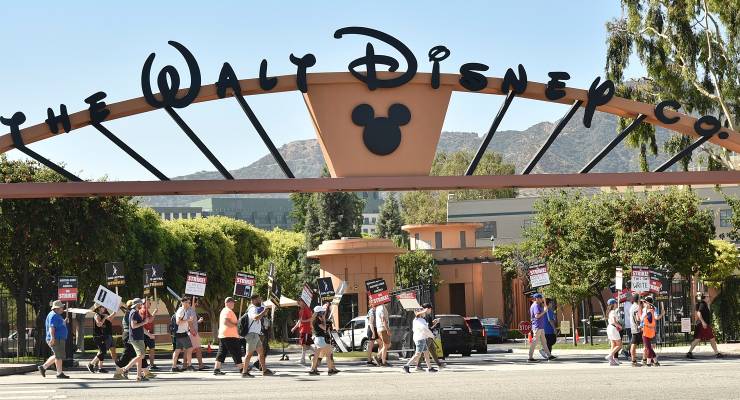
The still unknowable outcome of the Hollywood strikes — first by the Writers Guild and now by the actors union SAG-AFTRA — will shape two consequential shifts in the global entertainment industry: the streaming shake-up of the past decade and the artificial intelligence revolution of the next.
It’s “Hollywood” only in the most metaphorical sense, with the place standing in for what’s become a globalised industry, with deep roots here in Australia. The strikes’ result will determine not only what sort of industry Australia has, but whether it has much of an industry at all.
Australians have already been affected by the strikes, with suspended offshore productions (and about 150 local actors and crew stood down) at Gold Coast’s Village Roadshow studio for Mortal Kombat 2 (to be distributed by one of the big US studios, Warner Bros) and Universal’s Apples Never Fall. Apple TV’s production of Metropolis, which was due to start at Melbourne’s Dockland studios, has been cancelled.
The Media, Entertainment & Arts Alliance (MEAA), which organises both performers and crew, is supporting the US strike, advising its members that “Australian actors and crew engaged on offshore screen productions with imported US performers/SAG-AFTRA members in lead roles and engaged on SAG contracts … may be affected and you may be stood down without pay”.
Australia’s involvement is the result of our quarter-century integration into the US industry, encouraged by both state and federal governments with subsidised studio developments (like Disney, at Sydney’s Moore Park), tax benefits (such as waiving payroll tax), and cash contributions that offset local expenditure.
One of the key components of the Labor government’s cultural package in this year’s federal budget was to increase from 16.5% to 30% the local expenditure paid to the big studios to lure so-called “footloose” productions, at a four-year cost of $112.2 million. But it’s not all one way. Off-shore productions provide a weight of jobs and infrastructure that, in turn, support the local production economy.
The US unions have followed the money, with SAG-AFTRA’s “global rule one” insisting that its members anywhere in the world (including Australian members) can only work under a union contract. Sure, our weather is great and workforce skills are high, but the real attraction is we’re cheaper than California. If the Alliance of Motion Picture and Television Producers can break the union-enforced costs at home, why bother coming here?
The tensions have already prompted Disney boss Bob Iger to say the quiet part out loud: the big five studios reckon linear television — that now weird-seeming 20th-century delivery of one program after another at pre-set times on either free-to-air or pay television — is done.
Disney is the largest of the studios (here in Australia, too) and is deep into linear assets, owning one of the big three US television networks (ABC) and drama, sport and documentary cable channels, like FX, which it inherited as part of the 2019 takeover of 20th Century Fox’s entertainment assets. Looks like all of these are now up for sale.
If a giant like Disney can’t make linear television work in the large US market, what chance do Australia’s networks have? We got some idea last week with leaked figures showing our own ABC is rotting from the bottom up, demographically speaking: two-thirds of the flagship 7pm news audience is aged over 65, while only 8% are under 40. (Australia’s median age is 38.5.)
Where’s the rest of the audience? Same place you probably are, watching one of the half-dozen mainly US-owned or programmed streaming services (like Disney+) competing for your eyeballs.
Trouble is, as the global streaming giants increasingly monopolise our attention, they eat into the income of creative workers like writers and actors. Over the past 50 years, as distribution has diversified by platforms (from cinemas, to free-to-air TV, pay TV and DVDs), by geography and by time, incomes have increasingly relied less on one-off payments and more on continuing residuals with each on-sale of rights.
Now most productions are heading straight to streaming with global distribution, while the economics of monopoly are pushing the big streamers to cut costs by commodifying their offering: more mass, less boutique, lower production values. In an interview, Iger said Disney would be reducing production: “Not just to focus, but it’s also part of our cost containment initiative. Spending less on what we make, and making less.”
A strike over the streaming disruption would be hard enough. But this year’s round of the industry’s contract renewals has crashed into the leap in capabilities (and fall in cost) of generative artificial intelligence, which threatens to replace some of the work of both writers and performers.
The studios want to push talk about AI off to the unknown future, just as they did previously with streaming. This time around, the Australian industry should be grateful that the US unions are being significantly less trusting.








it’s been fascinating to watch these unions (and others) in the US, The Home Capitalism™ – they’re doing stuff that would be illegal in Australia with our anti-union laws
I notice at least one News Corpse article about ‘millionaire union boss, Fran Drescher’ in the Explorer links this afternoon.